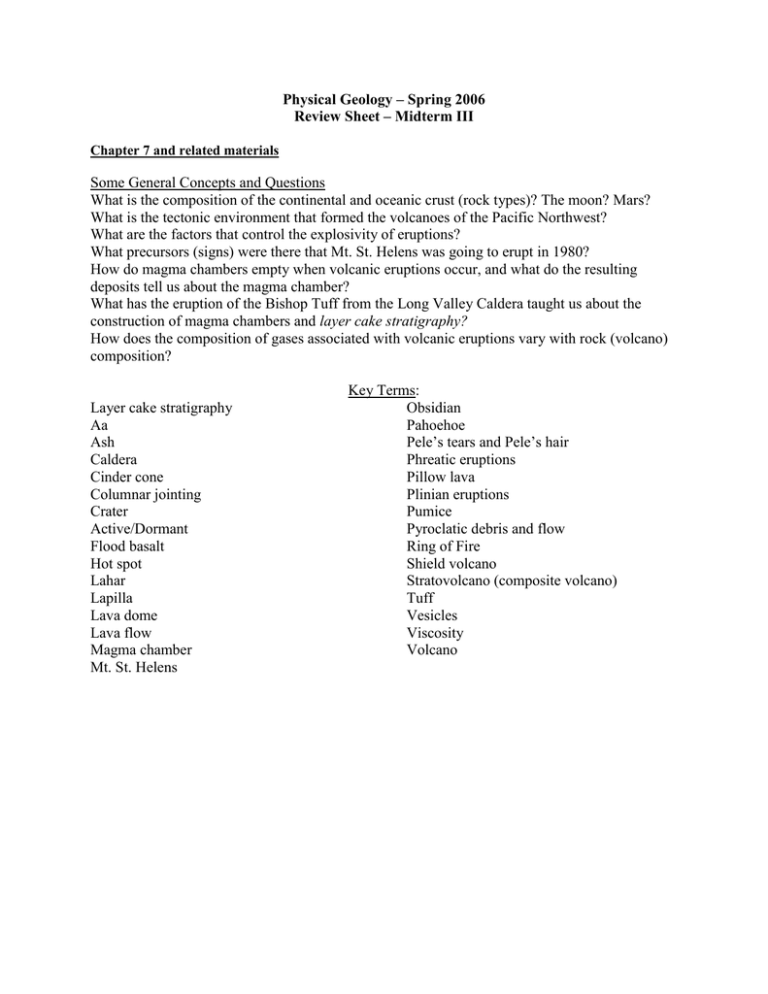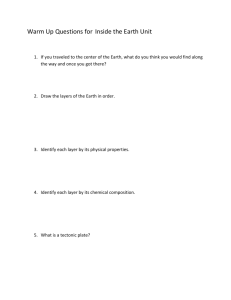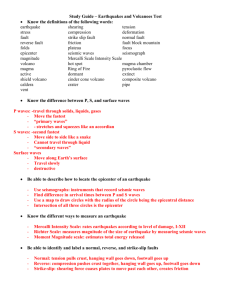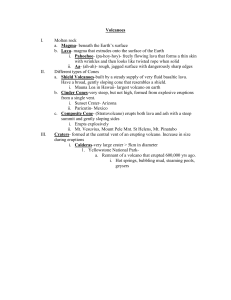Study Guide Exam 3 (DOC)
advertisement

Physical Geology – Spring 2006 Review Sheet – Midterm III Chapter 7 and related materials Some General Concepts and Questions What is the composition of the continental and oceanic crust (rock types)? The moon? Mars? What is the tectonic environment that formed the volcanoes of the Pacific Northwest? What are the factors that control the explosivity of eruptions? What precursors (signs) were there that Mt. St. Helens was going to erupt in 1980? How do magma chambers empty when volcanic eruptions occur, and what do the resulting deposits tell us about the magma chamber? What has the eruption of the Bishop Tuff from the Long Valley Caldera taught us about the construction of magma chambers and layer cake stratigraphy? How does the composition of gases associated with volcanic eruptions vary with rock (volcano) composition? Layer cake stratigraphy Aa Ash Caldera Cinder cone Columnar jointing Crater Active/Dormant Flood basalt Hot spot Lahar Lapilla Lava dome Lava flow Magma chamber Mt. St. Helens Key Terms: Obsidian Pahoehoe Pele’s tears and Pele’s hair Phreatic eruptions Pillow lava Plinian eruptions Pumice Pyroclatic debris and flow Ring of Fire Shield volcano Stratovolcano (composite volcano) Tuff Vesicles Viscosity Volcano Chapter 8 and related materials Some General Concepts and Questions What are the major kinds of faults, and how do they relate to tectonic environment? How do scientists locate the epicenter of an earthquake? What are common rates of tectonic processes? What are the 3 scales commonly used to characterize the strength of an earthquake? What are the advantages/disadvantages of each? How are maps of seismic risk arrived at? How can geologists get information about the mantle and core of the Earth? What are S-wave and P-wave shadow zones, and why are they generated? Why are some of the largest earthquakes in US history along the New Madrid fault zone? Why was the December 2004 tsunami in Indonesia so destructive? How does the seismicity vary as a function of the different types of plate tectonic boundaries? Active fault Arrival time Benioff zone (Wadati Benioff Zone) Body waves Compressional waves Displacement Earthquake Epicenter Focus Foot wall Hanging wall (head wall) Intraplate earthquakes Liquefaction Love waves Mercalli intensity scale Moment magnitude Normal fault P-waves Key Terms Rayleigh waves Reverse fault Richter scale S-P gap S-waves San Andreas Fault Seismicity Seismic tomography Seismogram Seismometer (seismograph) Shadow zones Shear waves Strike slip fault Thrust fault Travel time Tsunami Chapter 9 and related materials Some General Concepts and Questions What are the kinds of deformation? How can brittle materials behave in a ductile fashion? What are the 4 factors that control how rocks respond to stress? What are the 3 principle types of stress? What is the symbol and how is it used to delineate folds on geologic maps? What are the relative ages of rock layers in domes, basins, synclines and anticlines? anticline axial plane basin brittle deformation compression craton deformation dip displacement dome ductile deformation erosion fault scarp fold hinge Key Terms isostacy isostatic adjustment (compensation) joint limbs monocline offset original horizontality orogeny plunge relief (topographic relief) sediment loading stress strike syncline uplift Chapter 14 and related materials Some General Concepts and Questions How much of the Earth’s water is present in the oceans? Glaciers? Groundwater? Etc. What are the ways in which rock material is transported downstream? What are the factors that will make base level rise? Fall? What is isostacy and isostatic rebound, and how can the concepts be used to evaluate melting glaciers, continents floating on the mantle and water evaporating in lakes? Where are the major divides in North America? What are the 4 major types of drainage networks? What is the recurrence interval of floods? How can it be used in flood prediction? Have an understanding of the hydrologic cycle? What is Darcy’s Law and how can it be used to help understand the behavior of streams and rivers? What are the main types (morphologies) of stream channels? Alluvial fan Bar Base level Bed load Braided stream Channels Cut bank Delta Discharge Dissolved load Divide Drainage basin Flood Fluvial deposits Headwaters Levee Longitudinal profile Meandering stream Meanders Key Terms Oxbow Point bar Pothole Radial network Rectangular network Relief Recurrence interval Saltation Sediment load Stream gradient Suspended load Trellis network Tributaries Trunk stream Turbulence Water gap Watershed Water table








